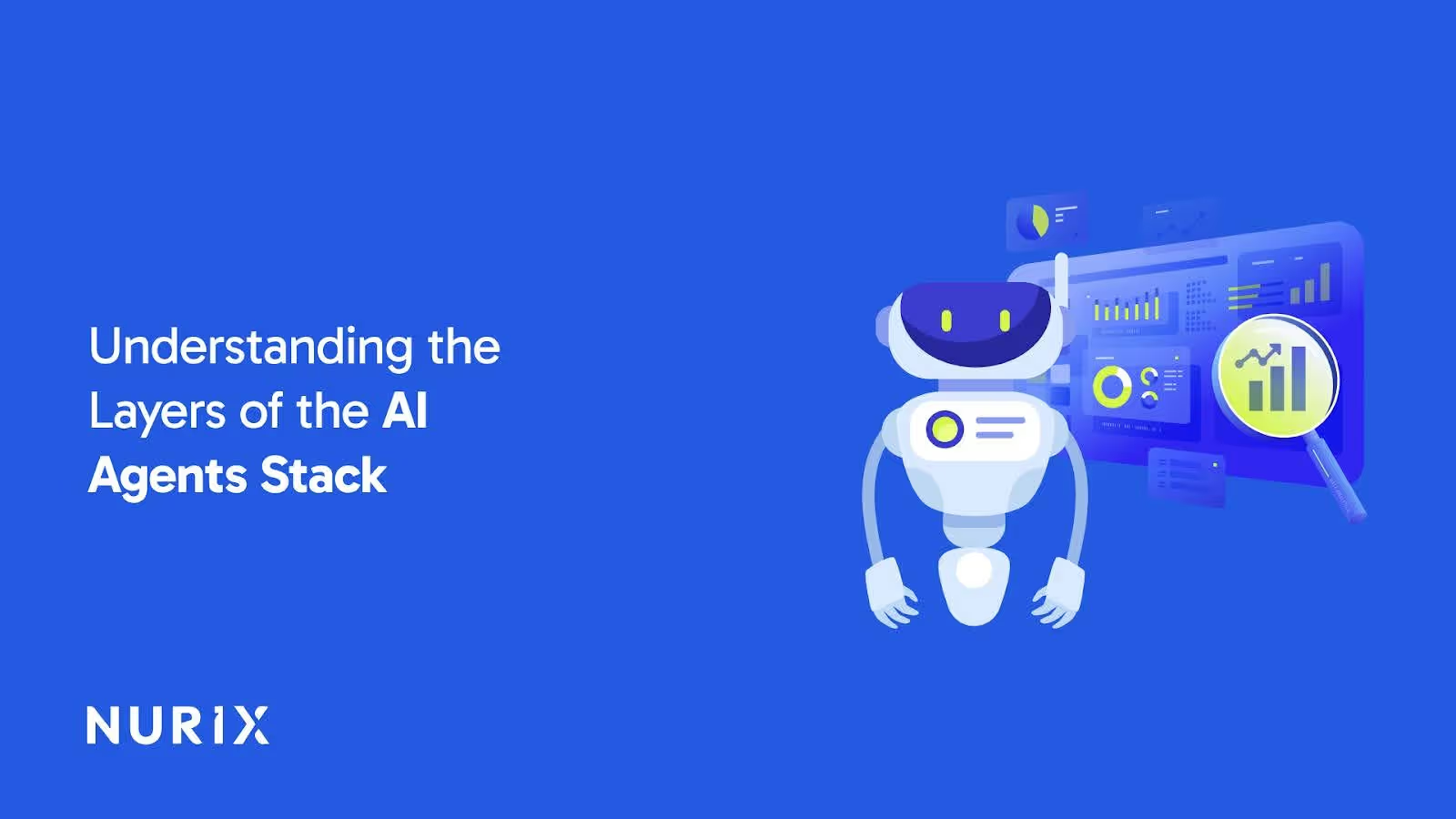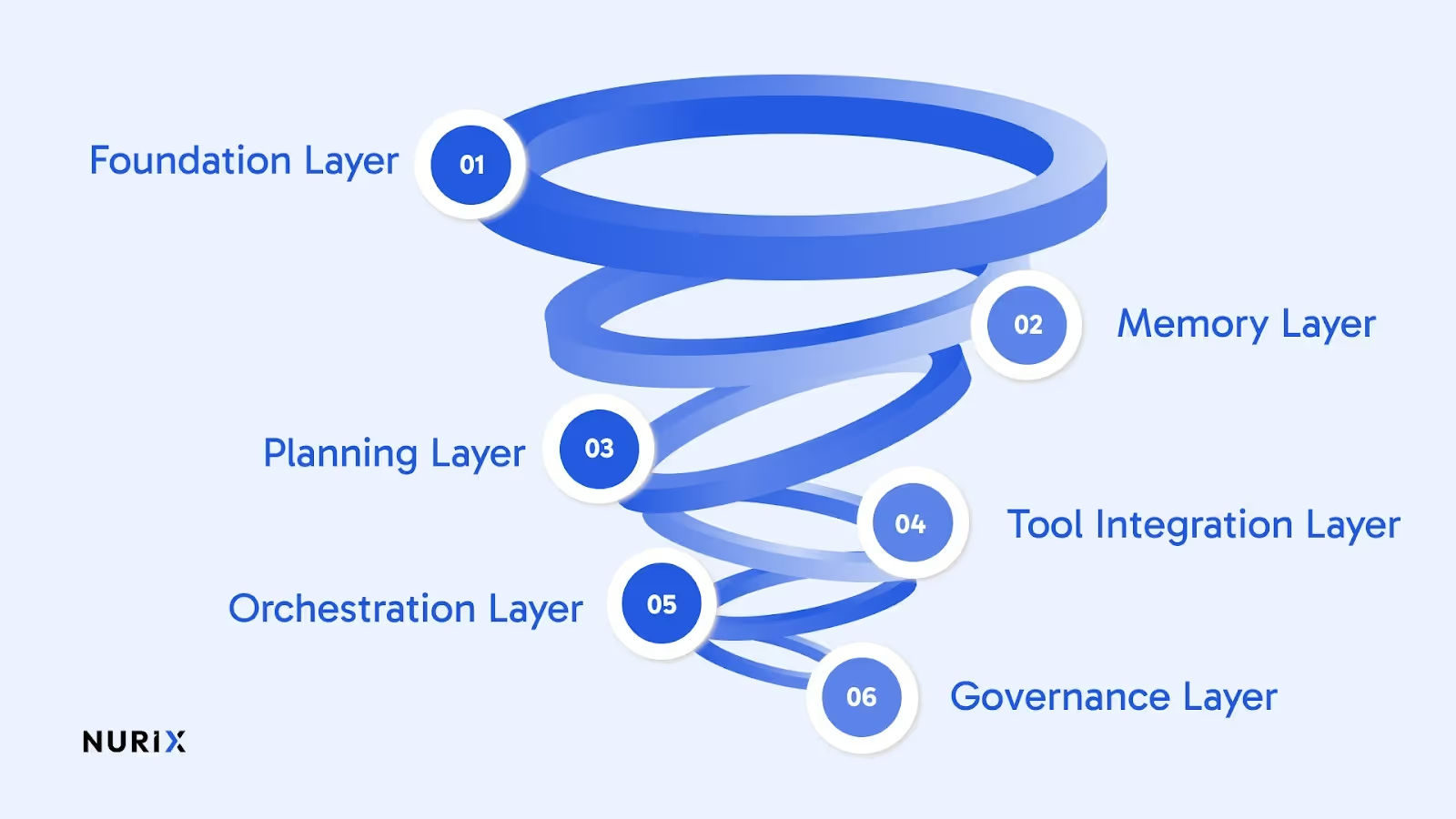Understanding the Layers of the AI Agents Stack

Struggling to bring AI agents into practical use? Many face repeated setbacks, not because of a lack of intelligence but because the components beneath the AI agents' stack are complex and fragmented. Missing links between models, frameworks, and execution layers often cause costly confusion and slow progress.
The market for AI agents reflects these challenges and opportunities. Valued at about USD 3.84 billion in 2024, it is expected to grow sharply to nearly USD 51.58 billion by 2032, as the demand for dependable AI solutions grows.
This guide focuses on breaking down the key layers within the AI agents stack to shed light on what makes these systems tick, helping professionals overcome integration challenges with clearer technical insight.
Takeaway
- AI Agent Stack Enables Contextual Intelligence: By combining foundational models with memory and planning layers, AI agent stacks maintain context and adapt actions across sessions for smarter workflows.
- Multi-Agent Coordination Handles Complex Tasks: The orchestration layer manages multiple specialized agents, ensuring smooth handoffs and collaboration for multi-step business processes.
- Security and Compliance Are Built In: Governance layers enforce strict security controls and continuous compliance monitoring to protect operations and maintain accountability.
- Tool Integration Expands Agent Capabilities: Connecting to external APIs and systems allows AI agents to perform real-world actions and extend beyond basic language understanding.
- Nurix AI Focuses on Human-Like Interaction: Nurix AI delivers conversational AI agents that not only automate tasks but also maintain natural dialogue with customers across voice and chat channels.
What is an AI Agent Stack?
An AI agent stack is a structured set of layers that work together to build and run AI agents capable of performing intelligent, autonomous tasks. It consists primarily of three layers: the Model Layer, which provides foundational AI models like language and vision processing; the Agent Framework Layer, responsible for planning, reasoning, and memory functions; and the Orchestration Layer that integrates tools, storage, and deployment mechanisms.
This stack collectively enables AI agents to manage complex workflows, hold contextual memory, and interact with external systems effectively.
Why Should Businesses Invest in an AI Agent Stack?
An AI agent stack advances business operations by orchestrating multiple intelligent systems that deliver accuracy, scale, and contextual insight across processes. This approach drives measurable improvements in decision-making, task automation, and customer engagement. Below are the key benefits of investing in an AI agent stack.
- Improved operational precision: AI agent stacks reduce errors by systematically managing tasks through machine learning, resulting in consistent, accurate business processes and data handling in complex environments.
- Continuous availability and support: Businesses gain around-the-clock support, enabling customer service and operations to run without downtime or delays, improving responsiveness regardless of time zones or employee hours.
- Scalable task automation: Automating routine and repetitive tasks across departments lowers operational costs and frees staff for strategic work, allowing business growth without proportionate increases in headcount.
- Context-aware decision-making: AI agent stacks analyze real-time data and company knowledge to offer relevant, insightful recommendations, leading to smarter choices and improved business agility.
- Strengthened customer engagement: By providing personalized, prompt interactions at scale, businesses can better meet customer expectations and foster customer loyalty through consistent, informed conversations.
- Simplified complex workflows: The layered architecture of the AI agent stack manages diverse tools and agents working in concert, enabling efficient handling of multi-step processes without loss of context.
- Reduced employee burnout: With AI agents handling repetitive inquiries and tasks, employees face less cognitive load, improving morale, retention, and job satisfaction within the workforce.
- Accelerated onboarding and training: Businesses benefit from faster new hire integration through AI-generated insights and real-time support, which speeds up productivity without prolonged training cycles.
Breaking Down the Layers of an AI Agent Stack

An AI agent stack organizes multiple layers that work together to address complex business needs through structured intelligence and control. Each layer has a distinct role, from core processing and memory management to tool integration and oversight, forming a comprehensive system.
Here’s a clear outline of these layers and how they function within an AI agent stack.
1. Foundation Layer
The foundation layer provides core computational capabilities and model access for agent reasoning and text generation. Large language models serve as the primary reasoning engines, enabling agents to process natural language instructions, analyze complex scenarios, and generate contextually appropriate responses.
Key Details:
- Model Integration: Houses foundational AI models, including language, vision, and speech processing systems, that provide core cognitive abilities for understanding multimodal inputs.
- Computational Infrastructure: Delivers scalable cloud or on-premise compute resources, including GPU clusters, managed services, and container orchestration platforms.
- API Gateway Management: Establishes standardized interfaces for model access, handles authentication protocols, and manages rate limiting across multiple foundational services.
2. Memory Layer
The memory layer enables agents to retain context, learn from past interactions, and maintain continuity across sessions through sophisticated storage mechanisms. This layer distinguishes between working memory for immediate tasks and persistent memory for long-term knowledge retention.
Key Details:
- Contextual Storage Systems: Implements vector databases and embedding generators to store semantic information, enabling agents to retrieve relevant historical data through similarity matching.
- Multi-Tier Architecture: Manages both short-term conversational context and long-term episodic memory, with automated consolidation processes that determine which information persists across sessions.
- Dynamic Memory Management: Includes intelligent filtering mechanisms that prioritize important information, decay irrelevant entries over time, and optimize retrieval speed through strategic data organization.
3. Planning Layer
The planning layer handles goal decomposition, task sequencing, and strategic reasoning to break complex objectives into executable steps. This cognitive component enables agents to analyze situations, evaluate alternatives, and develop coherent action plans.
Key Details:
- Goal Decomposition Engine: Uses chain-of-thought reasoning to break down high-level objectives into specific, measurable sub-tasks with clear dependencies and execution sequences.
- Strategic Reasoning Modules: Employs decision trees, hierarchical task networks, and algorithmic strategies to evaluate multiple approaches and select optimal execution paths.
- Self-Reflection Capabilities: Incorporates feedback loops that allow agents to assess progress, adapt strategies mid-execution, and learn from outcomes to improve future planning.
4. Tool Integration Layer
The tool integration layer connects agents to external systems, APIs, and services that extend their capabilities exceed pure language processing. This layer enables agents to perform real-world actions through controlled interfaces with business applications and data sources.
Key Details:
- API Orchestration Framework: Manages connections to external services through standardized protocols like OpenAPI specifications, enabling dynamic tool discovery and integration.
- Execution Environment Control: Provides secure sandboxed environments for code execution, web browsing automation, and interaction with enterprise systems while maintaining security boundaries.
- Tool Selection Intelligence: Implements contextual analysis to automatically select appropriate tools based on task requirements, availability, and previous execution outcomes.
5. Orchestration Layer
The orchestration layer coordinates multi-agent workflows, manages task distribution, and ensures coherent collaboration between specialized agents. This layer acts as the central conductor that synchronizes agent activities and maintains system-wide coherence.
Key Details:
- Workflow Coordination Engine: Manages task sequencing, agent handoffs, and state transitions across complex multi-step processes while handling error recovery and retry logic.
- Agent Communication Protocols: Establishes standardized messaging formats, data sharing mechanisms, and conflict resolution procedures for smooth inter-agent collaboration.
- Resource Allocation Management: Dynamically assigns computational resources, prioritizes tasks based on urgency and importance, and load-balances work across available agent capacity.
6. Governance Layer
The governance layer ensures agents operate within defined security, compliance, and ethical boundaries through comprehensive monitoring and control mechanisms. This layer provides oversight, auditability, and risk management across all agent operations.
Key Details:
- Security Control Framework: Implements multi-layered security measures, including runtime policy enforcement, input validation, and access control systems that limit agent actions to authorized scopes.
- Compliance Monitoring Systems: Maintains audit trails, ensures regulatory adherence, and provides real-time observation of agent activities for accountability and transparency requirements.
- Risk Mitigation Protocols: Establishes automated safety checks, human oversight triggers, and emergency intervention capabilities to prevent harmful or unintended agent behaviors.
Want to know about the latest breakthroughs reshaping automation and intelligence? Read more in Top AI Agents Dominating in 2025.
Building the Right AI Agent Stack With Nurix AI
Nurix AI is an enterprise-grade platform specializing in building conversational AI agents that automate customer support and sales workflows. Its agents support both voice and chat interactions, designed to act with human-like understanding and context awareness.
Nurix’s AI agents integrate smoothly with existing enterprise systems, offering fast deployment and compliance assurances while focusing on measurable business outcomes like operational cost reduction and customer satisfaction improvement.
Nurix AI Agent Stack Features
- Conversational AI Agents for Constant Support: Nurix AI agents handle repetitive queries and ticket resolution quickly, supporting 24/7 customer experiences with natural, human-like voice and chat interactions.
- Support for Every Step of Customer Workflow: From order support to smart escalation, these agents manage voice and chat assistance smoothly across inbound queries, status updates, returns, and subscription management.
- Round-the-Clock Load Management: AI agents ensure continuous coverage during peak and off-hours, automatically balancing queues and proactively managing surges without missing a beat.
- Intelligent Inquiry Routing and Triage: Built-in natural language intent detection and sentiment tagging allow AI to capture key details and route customer issues accurately, improving ticket quality and follow-up efficiency.
- Smooth Escalation and Human Handoff: Cases escalate to human agents with full conversation context, prioritization, and real-time notifications, preserving continuity and reducing resolution times.
- Unified Insights Dashboard: Businesses get consolidated voice and chat transcripts with real-time analytics on customer sentiment, deflection rates, and peak volumes to track and optimize support.
- Multichannel Context Continuity: Conversations maintain history across voice, chat, and other channels, so customers don’t need to repeat themselves, and agents pick up precisely where prior interactions left off.
- Flexible Integration Options: Nurix AI’s stack offers pre-built connectors for major CRM and support platforms, SDKs for web and mobile, and APIs to fit into virtually any enterprise workflow quickly and securely.
Nurix AI’s stack is more than automation; it is an intelligent, context-aware system that supports enterprises with natural, consistent interactions while driving measurable impact and operational streamlining.
Conclusion
An often underestimated component of the AI agents stack is the orchestration layer, which does more than just coordinate tasks; it establishes essential trust, governance, and the ability to adapt to complex, changing environments. Without this critical layer, even the most advanced models and tools can fail to deliver reliable and consistent results across diverse real-world situations.
Nurix AI stands out by providing a comprehensive platform that addresses these challenges head-on. Its architecture supports modular layering, strong error handling, and transparent traceability to improve agent reliability.
Key features include:
- Flexible multi-agent orchestration customized to diverse enterprise workflows
- Built-in monitoring and alerting for proactive issue resolution
- Extensible integration with existing AI models and business systems
- Secure data handling with audit trails for compliance needs
For teams ready to engineer AI agents with clarity and confidence, Nurix AI offers both the foundation and tools required. Get in touch with us to see how Nurix AI can help streamline the AI agents stack for your organization’s unique demands.
Managing agent roles and shared states is complex; misalignment in one agent’s output can disrupt entire workflows, making reliable multi-agent collaboration difficult.
Large models and distributed systems introduce latency that can degrade user experience, forcing trade-offs between speed and accuracy based on application needs.
Agents must navigate siloed and permissioned data environments, where incomplete or noisy data reduces reasoning accuracy and trustworthiness.
Monitoring, logging, debugging, and updating many agents at once remain underdeveloped, often leading to cryptic errors and prolonged troubleshooting.
Fragmented frameworks and varying APIs cause integration hurdles, requiring custom connectors that increase complexity, latency, and failure points.









